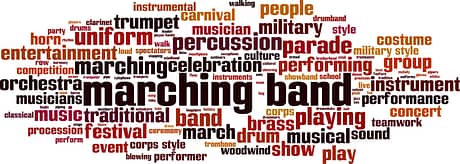 SBO+: We are pleased to announce that Barry Bernhardt, an accomplished teacher of the marching arts, will be a regular contributor to SBO+.
SBO+: We are pleased to announce that Barry Bernhardt, an accomplished teacher of the marching arts, will be a regular contributor to SBO+.
Basic Premise: All band rehearsals should begin with solid fundamentals to reinforce goals for that rehearsal.
SPECIFIC MARCHING BAND REHEARSAL TECHNIQUES:
BE PREPARED!
- Have a rehearsal plan for the week
- Have a rehearsal plan for that day
- Have long range rehearsal plans/goals
- Do your score study
- Structured visual warm-up:
- Since marching band is a physical activity, begin with stretching and body warm-ups in a rehearsal block.
The block helps to take attendance, helps to see what students are having difficulties and need further assistance, creates a more homogenous working atmosphere.
Use “Breathing Gym Daily Drills” to warm-up and relax the body.
Work on basic marching skills each day to reinforce good, unified technique.
- 8’s & 8’s forward and backward (w/BG)
- lateral slides and/or flanks (w/BG)
- flip flops (w/BG)
- specific or new body movement related to the show
Horn warm-ups:
- Begin with Remington Exercises (Concert F down to Concert BH), focusing on moving air/good posture,
- Have WW’s play and BR play on mouthpiece first time through
- Have all play exercise second time through.
- Continue with Remington Exercises (Tuning note Concert BH down to Concert F).
- WW’s play, BR on mouthpiece first time through
- All play exercise second time through
- BH Concert Scale in the round for balance, blend and tuning; Low’s, then mids, then highs.
- Tuning Chords; start on BH Concert Chord then down in ½ steps and back up to Concert BH Chord, then ALL to Concert BH for tuning.
Utilize some type of warm-up chorale or exercise
- School alma mater
- Maximum Strength Warm-Ups (Gary Gilroy)
- Ultimate Warm-Ups (Gary Gilroy)
- Something you create that addresses your band
Music rehearsal
- Rehearse music that will be the focus for that day
- Identify problem areas
- Have solutions to fix specific tuning or rhythmic concerns
- Sectionals on the music focus of the day
- Full music rehearsal with ALL captions
The use of specific warm-ups can be modified daily based upon the focus of that rehearsal. I suggest you stick to a warm-up each day, even if it is modified due to rehearsal length. Vary the warm-ups; visual, breathing, horns and music rehearsal so students are always encouraged to be engaged at every rehearsal. Do not dismiss the importance of quality warm-ups to bring focus and musicality to each rehearsal!
Field rehearsal
- Again, have a plan!
- Focus on learning objectives for that particular day/rehearsal
- Block drill/teach music/teach choreography all together
Teaching/Blocking Drill/Choreography
- Important that students know the music fairly well,
- Teach starting drill position, check spots, intervals, and body focus,
- Move to next drill spot, checking spots, intervals, and body focus,
- Drill back and forth between the two drill spots, so students learn path/flow with counts 2-3 times, adjusting where needed,
- In first drill position, play the music cue for that move while marking time, having guard/auxiliaries do their work,
- Run the drill move with music and choreography set 1 to set 2, 2-3 times for flow,
- Then, when at second page, repeat the process to the next drill position with a repeat of the previous process. Only do one music cue at a time while teaching the specific music cue,
At the end of teaching a new music cue with drill and/or choreography, run through from the beginning for continuity. This allows the students to assimilate the music cue with drill/choreography for that music cue.
This process does take more time initially, but the result is cleaner drill/choreography moves with good playing. At the end of the drill, your students will be able to play and move for the entire tune and then you just have to clean…much easier than teaching drill to counts and then adding in music/choreography! Better time management/less stress for all. With this system, you can teach a tune in one rehearsal!
End of rehearsal
- Review what has been taught for that rehearsal/day
- Run that portion of the show 2-3 times for continuity, so the students retain information.
- Address what is going to be taught at the next rehearsal
- Read new music for next rehearsal
- Work on stand tunes/ review choreography
- Brief meeting with student leaders/staff:
- Discuss rehearsal strengths and weaknesses
- Discuss plan for subsequent rehearsal(s)
- Discuss game day/travel plan when applicable
Barry W. Bernhardt is the Former Director of Bands/Director of Marching Band, Florida International University








